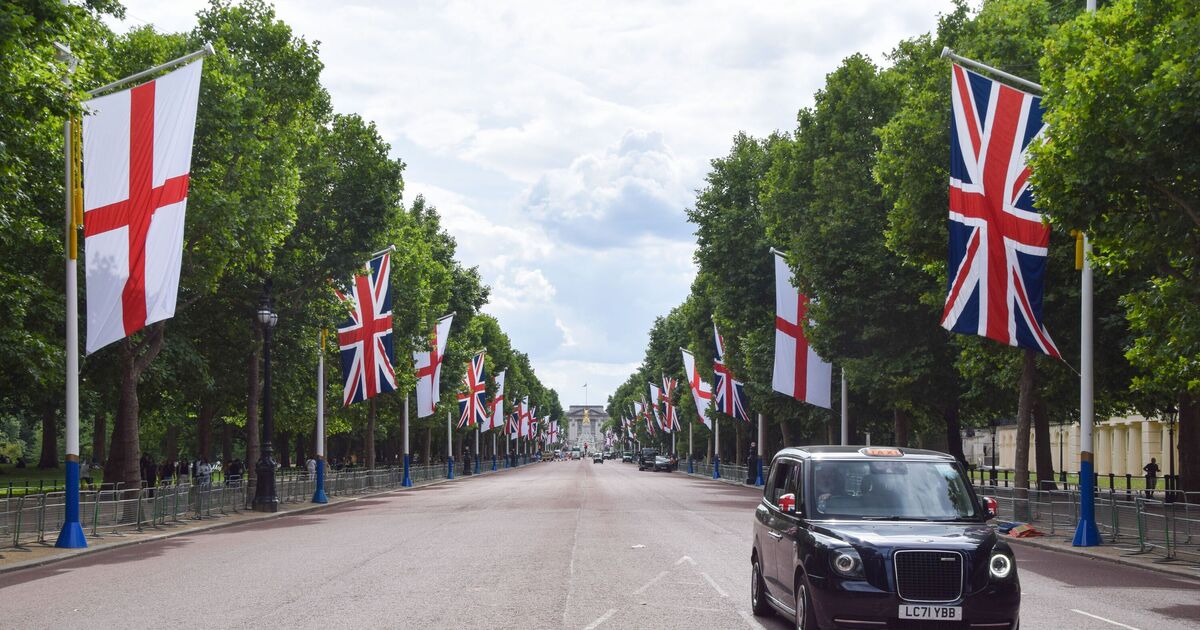A storm around the removal of Union Jack and England St George’s Cross flags being hauled down from streets of a major UK city has led more people to check what the rules and laws are governing the flying of flags in the UK.
‘Flag-gate’ kicked off last week after it was revealed Birmingham City Council had instantly removed both England flags and UK flags from being flown from lampposts, citing health and safety.
Since the controversy, a sort of flag resistance has kicked up in Birmingham, with locals spraying the St George’s Cross of England on roundabouts and hanging flags of the British Isles in protest in streets and on houses and flags being raised by the local authority in a u-turn.
But are there any flags which are banned in the UK?
The law on flying flags is surprisingly hands-off in the UK. There are local town planning rules in various council areas which set out how flags can be flown, and these rules list the flags which CAN be flown from houses and in public places without needing permission from anyone.
These include the UK constituent nations’ flags including the Union Flag (also called the Union Jack, both of which are acceptable names), the St George’s Cross of England, the Saltaire Saint David of Scotland, the Wales/Cmyru ‘Y Ddraig Goch’ Welsh flag and the Union Flag of Northern Ireland. The flag of Saint Patrick, or Saint Patrick’s Saltaire, which is a historic flag used in Northern Ireland before being replaced by the Northern Ireland Union Flag, also needs no permission.
Other flags that do not require permission to be flown, according to the government, include: “Any country’s national flag, civil ensign or civil air ensign.
“The flag of the Commonwealth, the United Nations or any other international organisation of which the United Kingdom is a member.
“A flag of any island, county, district, borough, burgh, parish, city, town or village within the United Kingdom.
“The flag of the Black Country, East Anglia, Wessex, any Part of Lincolnshire, any Riding of Yorkshire or any historic county within the United Kingdom
“The flag of any administrative area within any country outside the United Kingdom
“Any flag of His Majesty’s forces.
“The Armed Forces Day flag.”
As long as these flags or flagpoles do not display any advertisement or additions (e.g. using the flag to advertise your business), these are allowed with no permission. They also must be within certain size restrictions if flown from a flagpole.
Other flags which do not need permission to be flown, as long as they are within certain size limits, include sports clubs, the Rainbow/Pride flag, the NHS flag and various awards schemes like the Queen’s Awards for Enterprise and environmental flags like the Blue Flag award for beaches.
What flags are banned in the UK?
There is no list of flags enshrined in law which are explicitly banned in law in the UK, not even the Nazi Swastika. However, this is not to say that flying a certain flag cannot lead to a criminal offence. The context of how a flag is used determines whether an offence is committed.
For example, draping a Nazi flag outside a synagogue is likely to be deemed a hate crime, whereas using one in the filming of a historical drama is not. West Yorkshire Police says about the Nazi flag and symbols: “It is not currently a criminal offence to sell or own Nazi memorabilia in the UK.”
Having said this, the government does have a list of more than 70 ‘proscribed organisations’ under the Terrorism Act 2000, and flying a flag in public emblazoned with the name of one of these banned organisations, like Hamas, is more likely to be deemed an offence.
One of the categories of offence under this Act says: “wear clothing or carry or display articles in public in such a way or in such circumstances as to arouse reasonable suspicion that the individual is a member or supporter of a proscribed organisation.”
Such an item could be a flag with the name of an organisation on it.
According to the Herald, a document obtained under the Freedom of Information act from Police Scotland in 2018 listed 15 flags which could be illegal if used “in a provocative manner or altered” under breach of the peace laws.
The Herald reported: “Many of the flags included in Police Scotland’s list contain sectarian symbols and are often displayed by republican and loyalist groups during parades, while others are regularly seen on the terraces of Scottish football stadiums.
“However, several flags are official symbols of countries and territories across the world, including the Catalan flag which is displayed by supporters of Scottish independence.”
Police Scotland’s list of flags which are potentially criminal to display contained short descriptions of the significance of each flag and references armed struggles and perceived links to sectarianism.
The restricted police document stated: “Whilst the display of the following flags is not an offence, in itself, if flown or displayed in a provocative manner or altered, constitute a common law Breach of the Peace or an offence under Section 38 of the Criminal Justice and Licensing (Scotland) Act 2000.
“If they are altered to contain a reference to a proscribed organisation they may constitute an offence under Section 13 of the Terrorism Act 2000.”
This is similar to the proscribed organisations list – the flags of nations are not banned, but adding a reference to a banned organisation would then make flying them an offence.
The 15 flags on the list were:
The Orange Order flag
King William of Orange flag
The Sunburst
The Starry Plough
Vatican City State Flag
The Irish Tricolour
The Ulster Banner or “Red Hand Flag”
The Province of Ulster Flag
Leinster Flag
4 Provinces flag
Ulster Independence flag
Catalan flag
Basque flag
Palestinian flag
Israeli flag.

